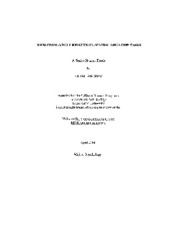| dc.creator | Andrew, Sarah | |
| dc.date.accessioned | 2013-02-22T20:39:36Z | |
| dc.date.available | 2013-02-22T20:39:36Z | |
| dc.date.created | 2004 | |
| dc.date.issued | 2013-02-22 | |
| dc.identifier.uri | https://hdl.handle.net/1969.1/ETD-TAMU-2004-Fellows-Thesis-A56 | |
| dc.description | Due to the character of the original source materials and the nature of batch digitization, quality control issues may be present in this document. Please report any quality issues you encounter to digital@library.tamu.edu, referencing the URI of the item. | en |
| dc.description | Includes bibliographical references (leaves 16-18). | en |
| dc.description.abstract | The relationship between menstrual cycle hormones and performance on gender-linked spatial tasks was examined in college women. Healthy women and men over the age of 18 and not taking hormonal preparations completed tasks that typically show a male advantage (mental rotation, targeting) or a female advantage (object location memory, verbal fluency). Men were tested at one session lasting one hour. Women were tested at two phases of the menstrual cycle, the peri-ovulatory phase and pre-menstrual phase. Cycle phases were determined using the Donna Mini-Microscope Ovulation Detector kit. Along with tracking their ovulation, women also documented their daily mood levels using visual analogue scales. Women were randomly assigned to two testing schedules: 1) ovulatory-->pre-menstrual, 2) pre-menstrual-->ovulatory. Further, women and men were randomly assigned to one of three test conditions: 1) neutral, 2) sad, or 3) threat. These assignments determined the stimuli that each participant was presented with during the object location task. Data were analyzed for expected sex differences (the between group comparison) and menstrual cycle effects (the within group comparison) in task performance. A trend was found where women tend to perform poorly during the ovulatory phase of the menstrual cycle on both cognitive and spatial tasks, when estrogen levels are highest, compared to their pre-menstrual performance. The data suggest that high estrogen levels impair spatial abilities, including spatial abilities that favor women. Ongoing subject testing will provide additional tests of the effects of emotional valence on task performance. | en |
| dc.format.medium | electronic | en |
| dc.format.mimetype | application/pdf | |
| dc.language.iso | en_US | |
| dc.publisher | Texas A&M University | |
| dc.rights | This thesis was part of a retrospective digitization project authorized by the Texas A&M University Libraries in 2008. Copyright remains vested with the author(s). It is the user's responsibility to secure permission from the copyright holder(s) for re-use of the work beyond the provision of Fair Use. | en |
| dc.subject | psychology. | en |
| dc.subject | Major psychology. | en |
| dc.title | Menstrual cycle effects on spatial location tasks | en |
| thesis.degree.department | psychology | en |
| thesis.degree.discipline | psychology | en |
| thesis.degree.name | Fellows Thesis | en |
| thesis.degree.level | Undergraduate | en |
| dc.type.genre | thesis | en |
| dc.type.material | text | en |
| dc.format.digitalOrigin | reformatted digital | en |


